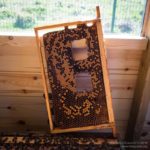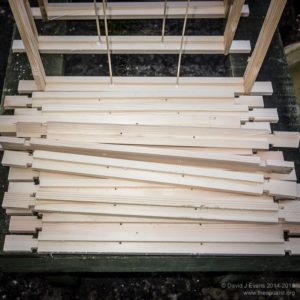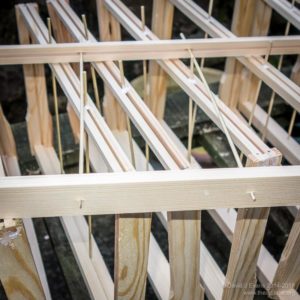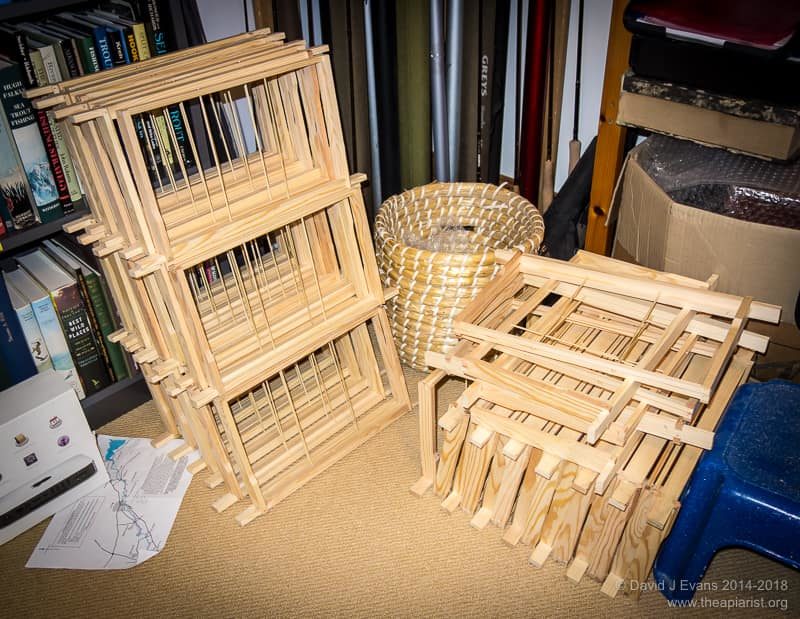Bamboo
I have been using increasing numbers of foundationless frames for the last couple of years. Rather than using a full sheet of embossed, wired foundation I let the bees draw the comb they need. I simply provide them with a frame containing some built-in support to provide lateral stability, together with a small strip (~1cm) of foundation to give them a clue where to start. They work very well. The newly drawn comb is beautiful and the bees draw drone and worker cells as needed. It can also save quite a bit of money.
Mono, wire … wood?
It is possible to use foundationless frames without any additional comb support. However, before it’s completely drawn and securely attached to the side bars it can be a little delicate. I therefore always provide some cross-bracing that can be incorporated into the newly drawn comb to give lateral support.
For the supports I’ve previously been using monofilament fishing line with a breaking strain of 30-50lb threaded through three pairs of holes drilled through the side bars. Although monofilament is inexpensive and easy to obtain, it’s a bit awkward and slow to ‘wire’ the frames and it doesn’t resist the heat of the steam wax extractor. Bees can also sometime nibble through the 30lb stuff whereas the 50lb – although thick enough to withstand the bee nibbling – is less easy to work with. Furthermore, for my day job we regularly harvest 2-3″ square sections of larvae- or pupae-containing brood comb (see the image above†). We do this with a sharp serrated knife. This often severs the monofilament and can leave the frame poorly supported. For these reasons I wanted to prepare foundationless frames with more robust supports for the season(s) ahead.
One option would be to use stainless steel wire. This would certainly be heat resistant. It’s widely available and relatively inexpensive. However, to get sufficient tension it might necessitate fixing eyelets to the side bars to stop the wire cutting into them. Whilst I was considering this there was a post on the SBAi forum suggesting the use of bamboo BBQ skewers. This may well have been suggested elsewhere‡ – there are few original ideas in beekeeping – but it was a new idea to me.
Skewered
BBQ skewers are available from an eBay in just about any length and amount you could want. One thousand 25cm skewers (the size needed for a standard National brood frame) cost less than a tenner delivered. You can buy 50 or 100 at a time to see if this method works for you (at a higher price per skewer, inevitably).
When preparing the frames I remove the ‘wedge’ and drill two equally-spaced holes through the middle of the top bar. Use a drill bit thinner than the bamboo skewer; I used one of 2.5mm. Assemble the entire frame including both bottom bars. If you’ve not experienced the epiphany of using a nail gun before I recommend borrowing one and discovering how easy it makes putting frames together. Put a small dab of woodworking adhesive (on the inside with regard to the frame) in each of the two holes in the top bar, slip the pointed end of the skewer through the gap in the bottom bars and push it firmly into the glued hole.
Straight and square
If there’s any curve to the bamboo skewer make sure its along the plane of the frame, not bowing out to one side or the other, by rotating the skewer in the hole. Or use a different skewer … they cost less than a penny each. Make sure the skewers are approximately square to the top bar and add another dab of glue either side of where they protrudes through the bottom bars.
Allow the glue to set and then cut off the unwanted pieces of bamboo. I used a Stanley knife for the top bar to get it nice and flush (so I could easily scrape it with a frame tool) and a pair of side cutting pliers for the bottom of the frame.
The resulting frame is then ready for the foundation. I’ll cover this in a separate post as I’ve been making my own starter strips.
† As an aside, the frame in the photograph titled ‘Harvesting brood’ is foundationless. It’s a perfect example of why lateral support is required to make these frames robust enough to handle easily. The bees have drawn the frame out completely but have only secured it to the side bars in a few spots. The comb isn’t attached to the bottom bars at all.
‡ A quick interwebs search turned up a post by Matt Davey on Beesource that lead me to his brief description of using bamboo skewers for foundationless frames. In addition, Kitta – the original poster on the SBAi forum – also kindly directed me to the Heretics Guide to Beekeeping, which is also worth a look. As I said before, if something is a good idea in beekeeping (or a bad idea), someone will have had it before 😉




Join the discussion ...